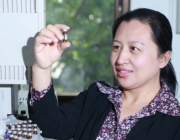Citation:
Peng JF, Hu M*, Guo S, Du ZF, Zheng J, Shang DJ, Zamora ML, Zeng LM, Shao M, Wu YS, et al. Markedly enhanced absorption and direct radiative forcing of black carbon under polluted urban environments. Proceedings of the National Academy of Sciences of the United States of America. 2016;113:4266-4271.
摘要:
Black carbon (BC) exerts profound impacts on air quality and climate because of its high absorption cross-section over a broad range of electromagnetic spectra, but the current results on absorption enhancement of BC particles during atmospheric aging remain conflicting. Here, we quantified the aging and variation in the optical properties of BC particles under ambient conditions in Beijing, China, and Houston, United States, using a novel environmental chamber approach. BC aging exhibits two distinct stages, i.e., initial transformation from a fractal to spherical morphology with little absorption variation and subsequent growth of fully compact particles with a large absorption enhancement. The timescales to achieve complete morphology modification and an absorption amplification factor of 2.4 for BC particles are estimated to be 2.3 h and 4.6 h, respectively, in Beijing, compared with 9 h and 18 h, respectively, in Houston. Our findings indicate that BC under polluted urban environments could play an essential role in pollution development and contribute importantly to large positive radiative forcing. The variation in direct radiative forcing is dependent on the rate and timescale of BC aging, with a clear distinction between urban cities in developed and developing countries, i.e., a higher climatic impact inmore polluted environments. We suggest that mediation in BC emissions achieves a cobenefit in simultaneously controlling air pollution and protecting climate, especially for developing countries.附注:
Dj7lvTimes Cited:36Cited References Count:42
